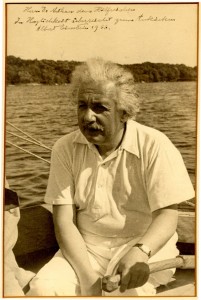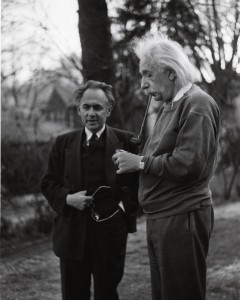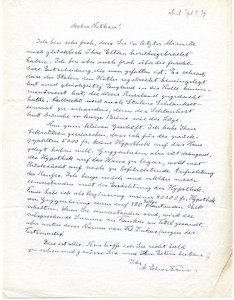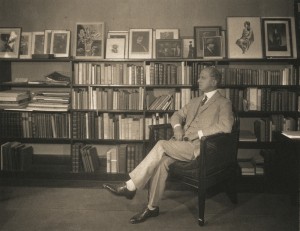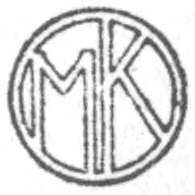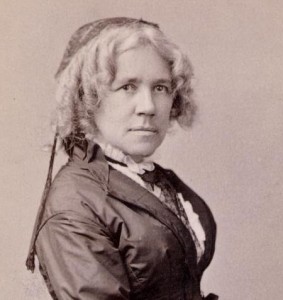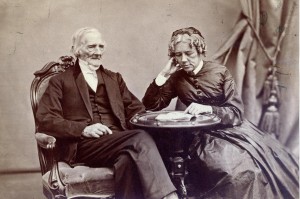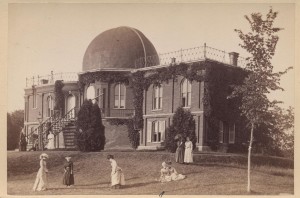Posted on behalf of the Office of Communications
For the past ten years, they’ve been a major pride point of the Special Collections at the Vassar Libraries: a collection of letters, manuscripts and photographs relating to Albert Einstein, notably including 130 letters exchanged between Einstein and his friend Otto Nathan, executor of the great scientist’s estate and a member of the college’s economics faculty in the early 1940s. Researchers from around the world have traveled to campus to study the collection. But now, thanks to a grant from Vassar alumna Dr. Georgette Bennett in honor of her husband, Dr. Leonard Polonsky, Vassar’s Einstein papers are being digitized, and will become available to a much wider audience.
“My husband and I are deeply committed to the democratization of knowledge through digitization of rare documents. Digitization of Vassar’s Einstein papers dovetails with our digitization of his collection at the Hebrew University in Jerusalem. We’re delighted to make Vassar’s valuable materials accessible to a worldwide audience,” said Dr. Bennett, a graduate of Vassar’s Class of 1967. The generosity of Dr. Bennett and Dr. Polonsky builds in turn on the original gift of the papers, more properly known as the Morris and Adele Bergreen Albert Einstein Collection, from Adele Gabel Bergreen of the Class of 1944. “To receive this grant was extraordinary,” said Sabrina Pape, Director of the Vassar Libraries. “We are so grateful to Dr. Bennett and Dr. Polonsky for allowing us to bring the collection to a worldwide community.”
While the Bergreen Einstein Collection includes other materials, Ronald Patkus, head of the Libraries’ Special Collections, said the grant from Dr. Bennett and Dr. Polonsky has allowed the digitization project to concentrate specifically on the papers and manuscripts. “The bulk of it is letters between Einstein and Otto Nathan about Einstein’s social and political concerns, especially those relating to Jewish-American organizations and individuals,” he said, adding that they shed light on “Einstein the humanitarian, which is a nice complement to the scientific Einstein.”
Read more online about the Morris and Adele Bergreen Albert Einstein Collection at Vassar College
According to Joanna DiPasquale, Digital Projects Librarian, the process itself involves placing the papers on flat-bed scanners and using high-resolution special equipment that “zooms down to photograph these incredibly fragile materials in a non-invasive way.”
“As an undergraduate institution, Vassar has many unique needs, “ DiPasquale said. “It’s my job to design a system to meet those needs.” The result in this instance is a new viewer that will enable a person looking at scanned Einstein materials to see the original German transcription side by side with its English translation – and there will be a full-text searchable database, in both English and German. Through a consortium that provides third-party backup storage of electronic documents, the digitization will also ensure the future integrity of the files by archiving them.
In addition, Vassar is partnering with such institutions as the California Institute of Technology, which has top experts at reading and translating Einstein’s papers, and the Hebrew University of Jerusalem, which is the official repository of the Albert Einstein Archives and home to the world’s largest collection of Einstein materials. “The result of the Vassar effort will be a standalone project that targets undergraduates,” said DiPasquale, “but it will also contribute to a larger digital collection of Einstein materials that will include both Vassar and Hebrew University materials.”
The digitization work has begun in earnest, with open online access to the documents expected to begin in early 2014. But as Pape stressed, that marks just the beginning of the effects of Dr. Bennett and Dr. Polonsky’s generosity, which also will include stipends for Vassar faculty members to explore ways of incorporating materials from the Bergreen Einstein Collection into their teaching. Faculty from such diverse disciplines as History, German Studies, Philosophy, Earth Science and Physics already have expressed interest.
“Opening up the collection for greater use across the curriculum is completely in keeping with our intent, and in keeping with a Vassar education,” said Dr. Bennett. “We are happy to make this possible.”

